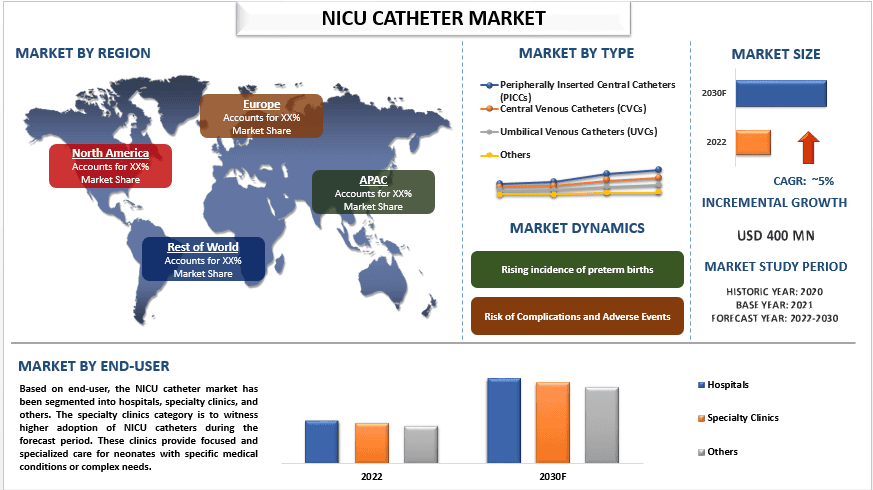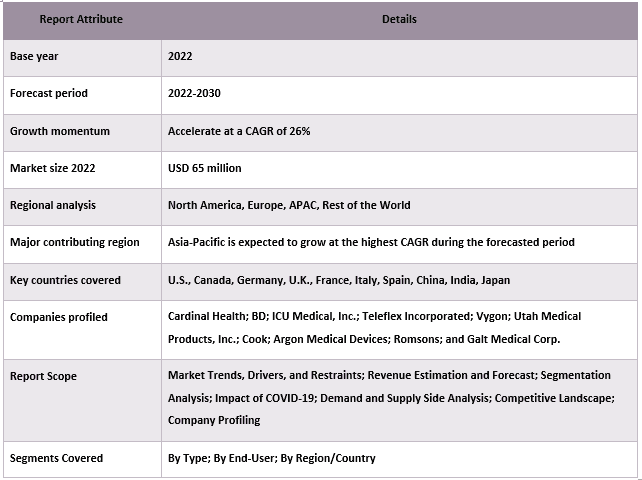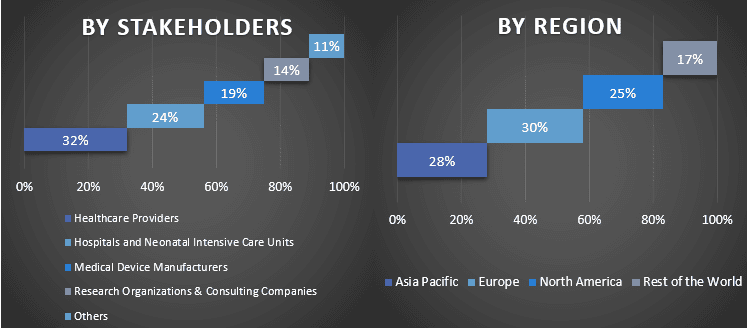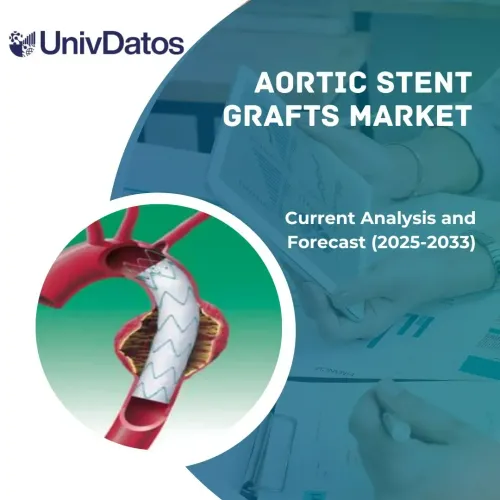- Home
- About Us
- Industry
- Services
- Reading
- Contact Us
NICU Catheter Market : Current Analysis and Forecast (2022-2030)
Emphasis on Type (Peripherally Inserted Central Catheters (PICCs), Central Venous Catheters (CVCs), Umbilical Venous Catheters (UVCs), and Others); End-User (Hospitals, Specialty Clinics, and Others); and Region/Country

The NICU Catheter Market was valued at USD 400 million in the year 2022 and is expected to grow at a CAGR of around 5% during the forecast period owing to the rising incidence of preterm births globally. For instance, as per the World Health Organization (WHO), an estimated 15 million babies are born preterm every year, and this number is rising. Moreover, the increasing focus on infection control in neonatal care. Catheter-associated infections pose a significant risk to neonates, and healthcare providers are actively seeking catheters with antimicrobial coatings and materials to mitigate this risk. The development of such catheters presents a significant opportunity for manufacturers in the market. Additionally, the expanding neonatal intensive care units (NICUs) and the growing awareness of specialized neonatal care. The establishment of dedicated NICUs and the rising demand for comprehensive neonatal care facilities create a favorable environment for the adoption of NICU catheters. Additionally, advancements in catheter materials and coatings have contributed to the prevention of catheter-related infections. The growing awareness of specialized neonatal care and investments in healthcare infrastructure, particularly in developing regions, provide substantial opportunities for market growth.
Some of the major players operating in the market include Schne Cardinal Health; BD; ICU Medical, Inc.; Teleflex Incorporated; Vygon; Utah Medical Products, Inc.; Cook; Argon Medical Devices; Romsons; and Galt Medical Corp. Several M&As along with partnerships have been undertaken by these players to facilitate customers with hi-tech and innovative products/technologies.
Insights Presented in the Report
“Amongst type, the central venous catheters (CVCs) category is expected to grow at significant growth”
Based on type, the market is segmented into peripherally inserted central catheters (PICCs), central venous catheters (CVCs), umbilical venous catheters (UVCs), and others. Amongst these, the central venous catheters (CVCs) category is expected to grow at significant growth. This is mainly due to these catheters providing reliable and direct access to central veins, enabling healthcare professionals to deliver essential therapies and monitor the patient’s condition effectively. With the increasing prevalence of chronic diseases and complex medical conditions in neonates, the demand for CVCs in NICUs has grown. As a result, the market for NICU catheters experiences substantial growth due to the widespread use and advancements in CVC technologies, including improved materials, designs, and insertion techniques, enhancing patient safety and overall clinical outcomes.
“Amongst end-user, the wireless smart home technology held the majority share of the market in 2022”
By technology, the market is segmented into hospitals, specialty clinics, and others. Among these, the hospitals category captured the majority share of the NICU catheter market in 2022. This is mainly due to the hospitals’ focus on infection control protocols and patient safety drives the adoption of catheters with antimicrobial coatings and enhanced safety features, contributing to the growth of the market. Furthermore, hospitals aim to deliver comprehensive and specialized care to newborns, which will increase demand for NICU catheters increases.
“APAC is expected to grow at the fastest growth rate during the forecast period.”
APAC is expected to grow at the fastest growth rate during the forecast period owing to rapid urbanization, improving healthcare infrastructure, and increasing healthcare expenditure in countries like China and India contribute to the region’s market growth. Moreover, the rising birth rate, a large population base, and a growing awareness of neonatal care drive the demand for NICU catheters in APAC. Technological advancements and the adoption of innovative medical devices in countries like Japan and South Korea further fuel market expansion. Additionally, the increasing focus on improving neonatal healthcare facilities and the establishment of specialized neonatal care units present significant opportunities for market growth in the region. For instance, by 2025, the Indian government plans to spend 2.5% of GDP on health care, up from 1.15 percent currently. In addition, in June 2021, the Ministry of Health in China received medical supplies purchased by UNICEF to improve the health of newborn babies.
NICU Catheter Market Report Coverage

Reasons to buy this report:
- The study includes market sizing and forecasting analysis validated by authenticated key industry experts.
- The report presents a quick review of overall industry performance at one glance.
- The report covers an in-depth analysis of prominent industry peers with a primary focus on key business financials, product portfolios, expansion strategies, and recent developments.
- Detailed examination of drivers, restraints, key trends, and opportunities prevailing in the industry.
- The study comprehensively covers the market across different segments.
- Deep dive regional level analysis of the industry.
Customization Options:
The global NICU catheter market can further be customized as per the requirement or any other market segment. Besides this, UMI understands that you may have your own business needs, hence feel free to contact us to get a report that completely suits your requirements.
Table of Content
Research Methodology for the NICU Catheter Market Analysis (2022-2030)
Analyzing the historical market, estimating the current market, and forecasting the future market of the global NICU Catheter Market were the three major steps undertaken to create and analyze the adoption of smart homes in major regions globally. Exhaustive secondary research was conducted to collect the historical market numbers and estimate the current market size. Secondly, to validate these insights, numerous findings and assumptions were taken into consideration. Moreover, exhaustive primary interviews were also conducted, with industry experts across the value chain of the global NICU Catheter Market. Post assumption and validation of market numbers through primary interviews, we employed a top-down/bottom-up approach to forecasting the complete market size. Thereafter, market breakdown and data triangulation methods were adopted to estimate and analyze the market size of segments and sub-segments of the industry pertains to. Detailed methodology is explained below:
Analysis of Historical Market Size
Step 1: In-Depth Study of Secondary Sources:
Detail secondary study was conducted to obtain the historical market size of the NICU Catheter Market through company internal sources such as annual reports & financial statements, performance presentations, press releases, etc., and external sources including journals, news & articles, government publications, competitor publications, sector reports, third-party database, and other credible publications.
Step 2: Market Segmentation:
After obtaining the historical market size of the NICU catheter market, we conducted a detailed secondary analysis to gather historical market insights and share for different segments & sub-segments for major regions. Major segments are included in the report as product, technology, and end-users. Further country-level analyses were conducted to evaluate the overall adoption of testing models in that region.
Step 3: Factor Analysis:
After acquiring the historical market size of different segments and sub-segments, we conducted a detailed factor analysis to estimate the current market size of the NICU catheter market. Further, we conducted factor analysis using dependent and independent variables such as product, technology, and end-users of the NICU Catheter Market. A thorough analysis was conducted of demand and supply-side scenarios considering top partnerships, mergers and acquisitions, business expansion, and product launches in the NICU Catheter Market sector across the globe.
Current Market Size Estimate & Forecast
Current Market Sizing: Based on actionable insights from the above 3 steps, we arrived at the current market size, key players in the global NICU catheter market, and market shares of the segments. All the required percentage shares split and market breakdowns were determined using the above-mentioned secondary approach and were verified through primary interviews.
Estimation & Forecasting: For market estimation and forecast, weights were assigned to different factors including drivers & trends, restraints, and opportunities available for the stakeholders. After analyzing these factors, relevant forecasting techniques i.e., the top-down/bottom-up approach were applied to arrive at the market forecast for 2030 for different segments and sub-segments across the major markets globally. The research methodology adopted to estimate the market size encompasses:
- The industry’s market size, in terms of revenue (USD) and the adoption rate of the NICU Catheter Market across the major markets domestically
- All percentage shares, splits, and breakdowns of market segments and sub-segments
- Key players in the global NICU Catheter Market in terms of products offered. Also, the growth strategies adopted by these players to compete in the fast-growing market.
Market Size and Share Validation
Primary Research: In-depth interviews were conducted with the Key Opinion Leaders (KOLs) including Top Level Executives (CXO/VPs, Sales Head, Marketing Head, Operational Head, Regional Head, Country Head, etc.) across major regions. Primary research findings were then summarized, and statistical analysis was performed to prove the stated hypothesis. Inputs from primary research were consolidated with secondary findings, hence turning information into actionable insights.
Split of Primary Participants in Different Regions

Market Engineering
The data triangulation technique was employed to complete the overall market estimation and to arrive at precise statistical numbers for each segment and sub-segment of the global NICU Catheter Market. data was split into several segments & sub-segments post studying various parameters and trends in the areas of the product, technology, and end-users in the global NICU Catheter Market.
The main objective of the Global NICU Catheter Market Study
The current & future market trends of the global NICU Catheter Market were pinpointed in the study. Investors can gain strategic insights to base their discretion for investments on the qualitative and quantitative analysis performed in the study. Current and future market trends determined the overall attractiveness of the market at a regional level, providing a platform for the industrial participant to exploit the untapped market to benefit from a first-mover advantage. Other quantitative goals of the studies include:
- Analyze the current and forecast market size of the NICU Catheter Market in terms of value (USD). Also, analyze the current and forecast market size of different segments and sub-segments.
- Segments in the study include areas of the product, technology, and end-users.
- Define and analysis of the regulatory framework for the smart home
- Analyze the value chain involved with the presence of various intermediaries, along with analyzing customer and competitor behaviors of the industry.
- Analyze the current and forecast market size of the NICU Catheter Market for the major region.
- Major countries of regions studied in the report include Asia Pacific, Europe, North America, and the Rest of the World
- Company profiles of the NICU Catheter Market and the growth strategies adopted by the market players to sustain in the fast-growing market.
- Deep dive regional level analysis of the industry
Related Reports
Customers who bought this item also bought










